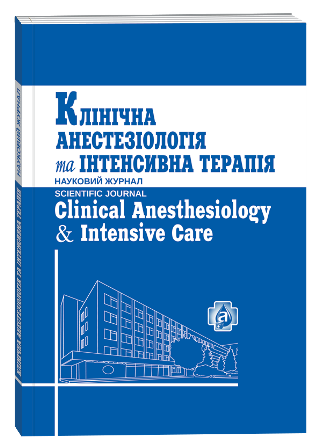THE COMPARISON OF THE EFFECTIVENESS OF THE VARIOUS METHODS OF PAIN MANAGEMENT AFTER ABDOMINAL OPEN SURGERY
DOI:
https://doi.org/10.31379/2411.2616.13.1.2Keywords:
postoperative analgesia, epidural analgesia, bilateral rectus sheath block, lidocain, laparotomyAbstract
Objectives: The goal of the study is comparing the comparison of the effectiveness of various methods of postoperative analgesia. Design, Materials, Methods: the study was included 38 male patients after open abdominal aortic surgery, all of them underwent the standard pre-procedure examination, anesthesia and intensive care (IC). There were 3 comparable groups. The first group included the epidural analgesia by ropivocain. The second group was bilateral rectus sheath blocks by ropivocain. The third one was the intravenous infusion of lidocaine. We evaluated the system of hemodynamic parameters, the data of pupillometry, several scales of analgesia, emotional and neurological status (VAS, Wong-Baker, SF-36, ММSE, HADS), nociceptional index by ANI-monitors. We used non-parametrical criteria such as Mann Whitney U-test, one-sample Wilcoxon test for the statistical analysis. Results. Fluid therapy has been discontinue after 12h in the 2nd group, 1st and 3rd groups – fluid administration was needed of 6-12 ml\kg (p<0,01). Current study show that all method analgesia is effective and associated with decrease VAS pain scores. We found predominantly bradycardia and hypotension in other groups. Two patients from the 1st group got epidural hematomas. Method analgesia did not have a positive impact on length of intensive care unite and of hospital stay (7,1±2,9). Complications had negative effect on length of intensive care unite and of hospital stay ( 23±9 days). Conclusions. Epidural analgesia is «Gold standard», but patients with cardiovascular disease are used antiplatelet and anticoagulant therapy to needed of alternative methods analgesia. All method analgesia is effective and associated with decrease VAS pain scores. Overall, a multimodal analgesic (+Bilateral rectus sheath blocks) approach may be used when treating postoperative pain, as it has few side effects. Bilateral rectus sheath block is simple method. The subjective evaluation of pain syndrome did not match with the objective criteria.
References
Tong J. Gan. Poorly controlled postoperative pain: prevalence, consequences, and prevention. / Tong J. Gan // J Pain Res. – 2017. – Vol. 10. – P. 2287–2298.
Pain intensity on the first day after surgery: a prospective cohort study comparing 179 surgical procedures. / H.J. Gerbershagen [et al.] // Anesthesiology. –2013. – Vol. 118(4). – P. 934-44.
Kubricht, V., Sevcik, P. Chronic postsurgical pain in mixed surgical population. Does an acute pain service make a difference? / V. Kubricht, P. Sevcik // Bratislava Medical Journal. – 2017. – Vol.118, No.12. – P.746-751.
Dayoub, E.J., Jena, A.B. Does Pain Lead to Tachycardia? Revisiting the Association Between Self-reported Pain and Heart Rate in a National Sample of Urgent Emergency Department Visits. / E.J. Dayoub, A.B. Jena // Mayo Clin Proc. –2015. – Vol. 90(8). – P. 1165-6.
Guay, J., Nishimori, M., Kopp, S.L. Epidural Local Anesthetics Versus Opioid-Based Analgesic Regimens for PostoperativeGastrointestinal Paralysis, Vomiting, and Pain After Abdominal Surgery: A Cochrane Review. / J. Guay, M. Nishimori, S.L. Kopp // Anesth Analg. – 2016. – Vol. 123(6). – P.1591-1602.
Weiss, R., Pöpping, D.M.Is epidural analgesia still a viable option for enhanced recovery after abdominal surgery. / R. Weiss, D.M. Pöpping // Curr Opin Anaesthesiol. – 2018. – Vol. 31(5). – P.622-629.
Eipe, N., Gupta, S., Penning, C.J. Intravenous lidocaine for acute pain: an evidence-based clinical update. / N. Eipe, S. Gupta, C.J. Penning // BJA Education. – 2016. – Vol. 16, Iss. 9. – P. 292–298.
Continuous intravenous perioperative lidocaine infusion for postoperative pain and recovery in adults. / S. Weibel [et al.] // Cochrane Database Syst Rev. – 2018. – Vol. 6.
The surgical rectus sheath block for post-operative analgesia: a modern approach to an established technique. / E.J. Crosbie [et al.] // Eur J Obstet Gynecol Reprod Biol. – 2012. – Vol. 160(2). – P. 196-200.
The Burden of Opioid-Related Adverse Drug Events on Hospitalized Previously Opioid-Free Surgical Patients. / R.D. Urman [et al.] // J Patient Saf. –2019.
Haematoma and abscess after neuraxial anaesthesia: a review of 647 cases. / E.M. Bos [et al.] // Br J Anaesth. – 2018. – Vol. 120(4). – P. 693-704.
Subdural Thoracolumbar Spine Hematoma after Spinal Anesthesia: A Rare Occurrence and Literature Review of Spinal Hematomas after Spinal Anesthesia. / P. Maddali [et al.] // Cureus. – 2017. – Vol. 9(2).
Contemporary Approaches to Perioperative IV Fluid Therapy. / P.S. Myles [et al.] // World J Surg. – 2017. – Vol. 41(10). – P. 2457-2463.
Al-Mazrou, A.M., Kiely, J.M., Kiran, R.P. Epidural analgesia in the era of enhanced recovery: time to rethink its use? / A.M. Al-Mazrou, J.M. Kiely, R.P. Kiran // Surg Endosc. – 2018. [Epub ahead of print]
The Analgesia Nociception Index: a pilot study to evaluation of a new pain parameter during labor. / M. Le Guen [et al.] // Int J Obstet Anesth. – 2012. – Vol. 21(2). – P. 146-151.







